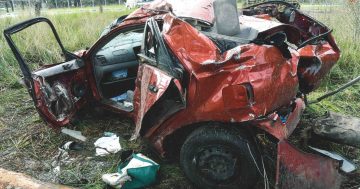
Just last month, a driver died on the Monaro Highway near the Royalla Solar Farm after a truck and car collided. Photo: Region Media.
For the second year running, the Monaro Highway in Hume is Canberra’s worst crash hotspot, despite 20 per cent fewer car accidents on that stretch of the road compared with last year.
According to the latest crash data from car insurer AAMI, Hume’s Monaro Highway and Fyshwick’s Canberra Avenue have been the scene of the most car accidents since 2015, with both main arterial roads taking out to the top two spots on Canberra’s top 10 accident sites.
AAMI spokesperson Anna Cartwright said the two stretches of road have at least 75 per cent more crashes on them compared with the third spot on Canberra’s list, which she believes is due to the high level of traffic.
“The Monaro Highway carries a lot of heavy vehicles, local traffic, as well as travellers driving into, and through Canberra to other locations, which can lead to traffic congestion, frustrated drivers and increased crashes,” Ms Cartwright said.
“Fyshwick’s Canberra Avenue is also a busy, major arterial taking drivers to and from the centre of Canberra. These hot spots are generally busy major arterial roads that are intersecting with local streets.
“When you combine this with heavy traffic and frequent stopping, it is a recipe for vehicle crashes.”
Analysing insurance claims from car accidents between 1 July 2018 to 30 June 2019, Belconnen’s Benjamin Way, the Barton Highway, Northbourne Avenue, Mugga Lane in Symonston and Gungahlin’s Gundaroo Drive, Anthony Rolfe Avenue and Gungahlin Drive all made the top ten.
ACT Minister for Roads Chris Steel said AAMI’s report supports the upgrades the ACT Government is making across the road network, which includes a $100 million project to design and construct grade-separated interchanges along the Monaro Highway near Hume.
“The ACT Government’s Monaro Highway upgrades will improve safety and traffic flow along the Highway through key intersections,” Mr Steel said. “The Monaro Highway upgrades are a priority for the ACT Government, and the data has again shown why.
“We have also committed funding to undertake a feasibility study to improve Hume circle on Canberra Avenue ranked second in the AAMI Index.”

Hume’s Monaro Highway has topped AAMI Crash Index. Graph: Supplied.
By revealing where accidents most commonly occur across the nation’s capital, AAMI spokesperson Phil Slade hopes motorists remember the importance of driving safely and being extra vigilant, particularly around the hot spots.
Mr Slade said the data also found that car accidents occurred more commonly when a driver is less than 10 km from home.
“When we’re driving somewhere we haven’t been before, somewhere novel, we’re more careful and concentrate more,” Mr Slade said. “On the flip side, when drivers are close to home, or on a familiar route, they can get too comfortable, they daydream, get distracted or tend to slip into autopilot.
“It is best to always expect the unexpected, leave plenty of room between you and the vehicle in front and be patient, especially if traffic is congested.”
Mr Slade said he believes the human emotions of frustration and impatience can also be causes for car accidents.
“If you’re running late, or if something or someone gets in your way or blocks your journey, even if it has no material impact on how quickly you’ll actually arrive at your destination, it’s your reactive self that tends to take control of your car, which makes it more difficult to control your emotions and make good decisions,” he said
“Drivers must be patient and present while driving if they want to avoid making an appearance as a statistic on next year’s data.”




















